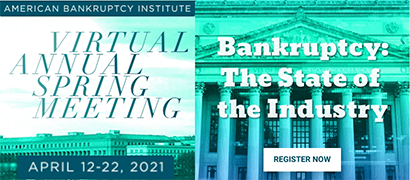| NEWS AND ANALYSIS |
|
As Paycheck Protection Program Runs Dry, Desperation Grows
The government’s $788 billion relief effort for small businesses ravaged by the coronavirus pandemic, the Paycheck Protection Program, is ending as it began, with the initiative’s final days mired in chaos and confusion, according to the New York Times. Millions of applicants are seeking money from the scant handful of lenders still making the government-backed loans. Hundreds of thousands of people are stuck in limbo, waiting to find out if their approved loans — some of which have been stalled for months because of errors or glitches — will be funded. Lenders are overwhelmed, and borrowers are panicking. Congress twice extended the program in December and March, anteing up nearly $300 billion total in new aid, but there is little indication that it will do so again. The relief program had been scheduled to keep taking applications until May 31. But two weeks ago, its manager, the Small Business Administration (SBA), announced that the program’s $292 billion in financing for forgivable loans this year had nearly run out and that it would immediately stop processing most new applications. Lenders suspected funds were running low, but — in a break from its practice last year — the SBA had not given them running updates on how much money remained. As a result, lenders had no warning that the end was imminent. Then the government threw another curveball: The SBA decided that the remaining money, around $9 billion, would be available only through community financial institutions, a small group of specially designated institutions that focus on underserved communities. Those organizations specialize in reaching businesses owned by women and minorities, a priority for the Biden administration. But they are not intended to operate on a large scale — and suddenly thousands of desperate borrowers have been beating down their door. Banks and other lenders are now frantically trying to find community financial institutions to take over their backlog of applications. Even though most focus on underserved borrowers, they can process loans for any qualified applicant — but very few have the capacity to do that in large numbers.

|
|

|
|
Analysis: Hundreds of PPP Loans Went to Fake Farms via Online Lender Kabbage
The shoreline communities of Ocean County, N.J., are a summertime getaway for throngs of urbanites, lined with vacation homes and ice cream parlors. However, dozens of Paycheck Protection Program (PPP) loans went to supposed farms that flowed into the beach towns last year, according to a ProPublica analysis. As the first round of the federal government’s relief program for small businesses wound down last summer, “Ritter Wheat Club” and “Deely Nuts,” ostensibly a wheat farm and a tree nut farm, each got $20,833, the maximum amount available for sole proprietorships. “Tomato Cramber,” up the coast in Brielle, N.J., got $12,739, while “Seaweed Bleiman” in Manahawkin, N.J., received $19,957. None of these entities exist in New Jersey’s business records, and the owners of the homes at which they are purportedly located expressed surprise when contacted by ProPublica. One entity categorized as a cattle ranch, “Beefy King,” was registered in PPP records to the home address of Joe Mancini, the mayor of Long Beach Township. “There’s no farming here; we’re a sandbar,” said Mancini, indicating that he had no cows at his home, just three dogs. All of these loans to nonexistent businesses came through Kabbage, an online lending platform that processed nearly 300,000 PPP loans before the first round of funds ran out in August 2020, second only to Bank of America. In total, ProPublica found 378 small loans totaling $7 million to fake business entities, all of which were structured as single-person operations and received close to the largest loan for which such micro-businesses were eligible. The overwhelming majority of them are categorized as farms, even in the unlikeliest of locales, from potato fields in Palm Beach to orange groves in Minnesota.

|
|

|
|
NY Fed: Mortgage Forbearance Helped Small Business Owners, Low-Income Households
Research released yesterday by the Federal Reserve Bank of New York on Wednesday indicated that mortgage forbearance was a lifeline for U.S. low-income homeowners and business owners who faced hardship during the pandemic, giving them the leeway to stay in their homes and keep up with other debt payments, Reuters reported. The end of that support could lead to a rise in mortgage delinquencies for many of the households still in forbearance, including low-income households and people who were behind on payments before the pandemic, researchers said. "Whether these forbearances are simply forestalling future trouble for strained business owners, or if the post-pandemic economy will support the owners to catch up on the lost months, remains to be seen," researchers wrote yesterday. The share of borrowers in forbearance rose sharply to over 7% in the early months of the pandemic, but many homeowners exited the program by the summer and just over 4% were in forbearance by late March 2021. A core group of borrowers, primarily consisting of people in low-income neighborhoods and those with loans insured by the Federal Housing Administration, stayed in forbearance for an extended period of time. Small business owners also tapped into the program at high rates, with 11% entering forbearance by May 2020, a share that dropped to about 5% by March 2021. People who owned service-sector businesses, which were disproportionately affected by pandemic-related restrictions, took up forbearance at higher rates. Business owners were more likely to tap into the equity in their homes using home equity lines of credit, the New York Fed found.

|
|

|
|
Jobless Claims Fall to 444K, Setting Another Post-Lockdown Low
The number of new applications for unemployment insurance fell last week to 444,000, according to data released today by the Labor Department, setting a new post-lockdown low for initial weekly jobless claims, The Hill reported. In the week ending May 15, first-time claims for jobless benefits fell by 34,000 from the previous week’s revised total of 478,000. For the sixth consecutive week, initial jobless claims hit their lowest level since March 14, 2020, when the final jobless claims report was released before the COVID-19 pandemic derailed the U.S. economy. The steady decline of jobless claims is an encouraging sign for the U.S. economy amid intense debate over why many businesses have reported trouble hiring new workers. The conflict over jobless benefits boiled over earlier this month after the April jobs report fell far short of expectations, showing a gain of 266,000 jobs despite projections of more than 1 million jobs created.

|
|
Cryptocurrency Scams Rose 1,000 Percent in the Past Year and Cost Consumers at Least $80 Million, FTC Says
Despite being highly volatile, the price of cryptocurrencies has surged to record levels, and scammers know that many people suffer from “FOMO,” or the fear of missing out, the Washington Post reported. Amid the cryptocurrency boom, there has been a tenfold increase in reported losses in the past 12 months from victims of cryptocurrency-related investment scams, according to new data from the Federal Trade Commission (FTC). Consumers have reported losing more than $80 million to cryptocurrency investment scams, the data shows. The FTC said it received nearly 7,000 scam reports in the last quarter of 2020 and the first quarter of 2021, 12 times the number reported over the same period a year earlier. The median amount consumers lost in the scams was $1,900. That is nearly 1,000 percent more in reported losses compared to the same period a year earlier, the agency said.

|
|
Analysis: Payday Lending in the Pandemic Has Been a Booming Business
Certain providers of payday and other high-interest loans are emerging from the pandemic stronger than perhaps ever before, a development that’s encouraging them to aggressively ratchet up lending now as the economy rebounds, Bloomberg News reported. Amidst a challenging time for millions of working-class Americans, there have been odd financial rhythms this past year, with its waves of job layoffs, followed by unprecedented government stimulus and a sharp economic rebound, and some high-interest lenders raked in record earnings. That the windfall for these companies came just as the Federal Reserve was making near-zero-rate loans available for corporate America and the wealthy only further riles up the industry’s biggest critics. “Debt collectors had a big year, and so did predatory lenders,” said Lauren Saunders, associate director at the National Consumer Law Center, a nonprofit that advocates for low-income borrowers. “The idea that any company could keep charging 100% or 200% interest or more during this time of crisis is really outrageous.” What’s more, consumer advocates point to studies that show that Black and Latino communities are disproportionately targeted by providers of high-cost loans. In Michigan, areas that are more than a quarter Black and Latino have 7.6 payday stores for every 100,000 people, or about 50% more than elsewhere, according to data collected by the Center for Responsible Lending. A forthcoming study from the University of Houston that was provided to Bloomberg shows similar disparities when it comes to online advertising. The COVID-19 outbreak and the economic fallout from efforts to contain it had the potential to be a major blow for consumer finance companies that cater to the 160 million Americans who don’t have good credit scores. They tightened lending standards in preparation for a surge in delinquencies as the unemployment rate rocketed past 14% last year. But this crisis proved to be different. Trillions of dollars in government stimulus, largely in the form of direct payments to low- and middle-income earners, helped countless people keep their heads above water financially. Many borrowers — facing the prospect of being chased by debt collectors and seeing their wages garnished — chose to spend at least some of the cash repaying their most expensive obligations. According to data collected by the Federal Reserve Bank of New York through March, U.S. households had used or planned to use about a third of the cash they received via stimulus checks to pay down debt. For families earning less than $40,000 a year or without a college degree, the share was closer to 40%.

|
|
After Shuttering During the Pandemic, Movie Theaters Get Ready to Reopen
Like so many businesses, the movie theater industry is looking to reopen its doors after having been ravaged by the economic effects of the pandemic, the New York Times reported. Theaters were starved of audiences when lockdowns went into effect, and studios delayed new releases or, in some cases, put them out on streaming services. Some chains have shut down and others have declared bankruptcy. AMC Entertainment’s chief executive, Adam Aron, said this month that the chain had been “within months or weeks of running out of cash five different times between April 2020 and January 2021.” The Alamo Drafthouse theater chain furloughed its 3,100 employees during the pandemic, declared bankruptcy in December, shut down three theaters as part of its restructuring and halted a planned project in Orlando. According to Shelli Taylor, Alamo’s new C.E.O., some 114 independent theaters and chain locations have shut down since the pandemic began, including the beloved ArcLight theaters in Hollywood. Many were hopeful they would receive money from the recent federal relief packages, but the Small Business Administration’s troubles with the disbursement of money kept many from staying afloat. According to exhibition research firm National Research Group, as of Monday some 70 percent of moviegoers are comfortable returning to the theater. The box office for April hit $190 million, up 300 percent since February. That’s a welcome relief to South African director Neill Blomkamp, whose new horror film “Demonic” from the indie outfit IFC will debut only in theaters at the end of August. One benefit of the pandemic has been a more flexible approach to how films are released. For years, exhibitors demanded roughly 72-90 days of exclusive theatrical exhibition before a film could become available on a streaming service or through premium video on demand. The pandemic has truncated that timeline, with the new window of exclusivity sitting at 45 days.

|
|
U.S. Banking Regulator to Rework Recently Updated Fair Lending Rule
A leading U.S. banking regulator announced on Tuesday that it was reconsidering a recently updated rule on fair lending standards, setting aside an effort finalized under the Trump administration, Reuters reported. The Office of the Comptroller of the Currency said it was revisiting a rule update completed in 2020 around the Community Reinvestment Act, a 1977 community lending law that requires banks to show how they are supporting lower-income communities. The agency added that banks no longer had to update their systems to comply with the 2020 modifications, and it was also shelving proposed rules related to implementing the rewrite. The move effectively acknowledges that the OCC is abandoning earlier efforts to update the rules single-handedly. Under former chief Joseph Otting, a Republican, the OCC pushed forward to update the rules, finalizing the new requirements in 2020 even as two other banking regulators that share responsibility for enforcing the law failed to do so. The Federal Deposit Insurance Corporation and Federal Reserve jointly share CRA authority with the OCC, but both agencies have yet to complete an update to rules around the law, which were last changed in 1995. The previous OCC effort was aimed at giving banks more clarity and flexibility in terms of what activities they could do to earn a passing grade with regulators. But some community groups and Democrats cautioned it could allow banks to do less to support lower-income communities while staying in regulators' good graces.

|
|
“Rewind” Any Annual Spring Meeting Sessions Through May 31
ABI’s Annual Spring Meeting has now concluded, but if you missed any of the hard-hitting sessions, replays are available through the innovative virtual platform. If you have registered for ASM, you can access the replays through May 31! Not registered? You can still sign up; click here.
|
|
Sign up Today to Receive Rochelle’s Daily Wire by E-mail!
Have you signed up for Rochelle’s Daily Wire in the ABI Newsroom? Receive Bill Rochelle’s exclusive perspectives and analyses of important case decisions via e-mail!
Tap into Rochelle’s Daily Wire via the ABI Newsroom and Twitter!
|
|
|
|
| BLOG EXCHANGE |
|
New on ABI’s Bankruptcy Blog Exchange: FDIC Asks Industry for Input on Digital Assets
The Federal Deposit Insurance Corp. on Monday issued a wide-ranging request for information on activities by banks to facilitate customers' use of cryptocurrencies and other digital assets, according to a recent blog post.
To read more on this blog and all others on the ABI Blog Exchange, please click here.
|
|
|
|













